Geological Terms Beginning With "H"
For terms beginning with other letters, please click below
|

Habit
An external shape displayed by an individual crystal or an aggregate of crystals. A few examples of crystal habits are shown in the photo. Clockwise from top left: prismatic habit; geodic habit; banded habit; pisolitic habit.

Haboob
A haboob is an intense dust storm caused by a downburst of air that mobilizes loose silt and clay and carries them across the landscape as a wall of dust. Haboobs usually occur in arid areas where the surface is covered with fine-grained materials that are easily mobilized. They can occur without warning and travel at speeds of up to 60 miles per hour. The wall of dust can be up to 60 miles wide and up to 2 miles in height. The image shows a haboob that hit Phoenix, Arizona on August 22, 2003. Public domain image by Wikipedian Junebug172.

Half-Life
The amount of time required for 1/2 of a radioactive isotope to decay into its daughter isotope.
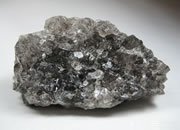
Halite
The mineral name for "rock salt." A chemical sedimentary rock that forms from the evaporation of ocean or saline lake waters. It is rarely found at Earth's surface, except in areas of very arid climate. It is often mined for use in the chemical industry or for use as a winter highway treatment. Some halite is processed for use as a seasoning for food.

Hand Lens
A small magnifying glass of about 10x power that is used in the field, office and laboratory by geologists to examine rock, mineral, fossil and other specimens. It is usually a folding device with a metal cover that, when closed, protects the lens from scratches and impact. Also known as a "hand magnifier," "pocket magnifier" or a "pocket lens." See this item in the Geology.com Store.
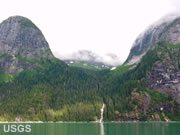
Hanging Valley
A tributary to a U-shaped glacial valley which, instead of entering the valley at the same level as the main stream, enters at a higher elevation, frequently with a waterfall. These different stream levels are a result of the rapid downcutting of the larger glacier being much faster than the slower downcutting of the tributary stream. The photo shows a hanging valley in Tongass National Forest, Alaska. The valley walls are about 1000 feet high and the valley is nearly 2000 feet wide.
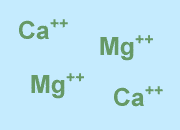
Hard Water
Water that has a significant amount of dissolved calcium and magnesium ions. This water performs poorly with most soaps and detergents and leaves a scaly deposit in containers where it is heated or evaporates. It can frequently be improved through the use of home-based water treatment systems.

Hardness
The resistance of a mineral to being scratched. Typically measured using the Mohs Hardness Scale.
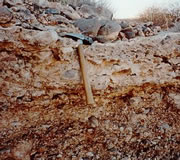
Hardpan
Hardpan, also known as caliche, is a surface or shallow layer in a soil or sediment in which the grains have been cemented together. Depending upon the degree of cementation, the layer might be thin and easily broken with a hammer, or it could be two or more meters thick and completely cemented. Hardpan is usually found in arid to semiarid areas where evaporation facilitates the precipitation of dissolved minerals in shallow sediments or soils. A hardpan layer can extend over hundreds of square kilometers and cause problems with drainage, agriculture, and construction.

Head
The upper part of a landslide's moving mass. It is located immediately below the scarp. Often when the scarp of a landslide becomes visible people will place soil on the head area to reestablish a smooth slope. This can be a mistake because it adds weight to the head and drives the slide.
Headwater(s)
The upper portions of a drainage basin where the tributaries of a stream first begin flow.
Heat Flow
The movement of heat energy from the core of the Earth towards the surface.
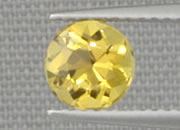
Heliodor
Heliodor is the name given to yellow to yellow-green gems of the beryl mineral group. They can be attractive, durable, high-clarity stones with a relatively low price. Surprisingly, they are infrequently seen in jewelry.

Hematite
An iron oxide mineral with a chemical composition of Fe2O3. It is the world's most important ore of iron. When crushed it forms a red powder that has been used as a pigment for thousands of years.

Hemimorphite
Hemimorphite is a zinc silicate mineral that occurs in white, blue and greenish blue colors. It is a minor ore of zinc. It is sometimes cut as a gemstone. These lack durability and are used as a collector's gem or in jewelry that will be subject to light wear.
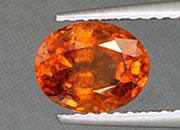
Hessonite Garnet
Hessonite is a variety of grossular garnet that is rich in iron and manganese. It has an orange to red-orange to reddish brown color and is sometimes called "cinnamon stone." It is occasionally cut into faceted stones and used in jewelry.
Hogback
A narrow ridge with steeply inclined sides of nearly equal slopes. Formed by differential erosion of steeply dipping rock units.

Hoodoo
An unusual pillar of rock that remains after the differential weathering or erosion of horizontal rock layers of varying physical properties. These structures can be caused by weathering along joints, less resistant rock units being selectively weathered, remnants from stream erosion and other processes. The name has an African origin where people imagined hoodoos being evil spirits or creatures in the form of stone.

Hornfels
A nonfoliated metamorphic rock that is typically formed by contact metamorphism around igneous intrusions.

Hornito
A small spatter cone that forms on the solidified surface of a lava flow where hot lava is still flowing below. An opening in the roof of the flow and pressure within can force a spattering of lava out of the opening. This lava can build up into a structure with a very unusual shape.

Horst
An elongated block of high topographic relief that is bounded on two sides by steeply dipping normal faults. Produced in an area of crustal extension such as the Basin and Range Province of the southwestern United States.

Host Rock
The barren rock that surrounds a mineral deposit. It is a term that is more specific and less geographically extensive than "country rock." Shown in the photo is gold in a quartz vein (right side) enclosed in basalt (left side).
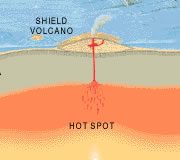
Hot Spot
A volcanic center located within a lithospheric plate that is thought to be caused by a plume of hot mantle material rising from depth and located above a "hot spot" on the outer core.

Hot Spring
A natural spring that delivers water to the surface that is of higher temperature than the human body. Hot springs form in areas where there is warm rock at shallow depth or where deep circulation brings hot waters up from deep within the earth. The image is a photo of Emerald Spring, a hot spring with a pool in Yellowstone National Park.
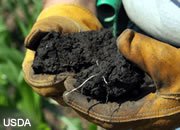
Humus
The dark portion of a soil that consists of organic material that is well enough decayed that the original source material cannot be identified.
Hydraulic Conductivity
The ability of a porous material to transmit a fluid. Also known as "permeability."

Hydraulic Mining
A mining method in which water is sprayed onto alluvium or unconsolidated sediment under high pressure for the purpose of disaggregating the particles and washing them through a sluice in the hope of recovering gold, gemstones or other heavy mineral particles. The method often caused great environmental damage by disrupting the land and flushing enormous tonnages of sediment into drainage basins. The photo from USGS shows hydraulic mining in Malakoff Diggings in the foothills of the Sierra Nevada in the 1870s.

Hydrocarbon
Any organic chemical compound (gaseous, liquid or solid) that is composed of carbon and hydrogen. The term is frequently used in reference to fossil fuels, specifically crude oil and natural gas.

Hydroelectric power
The production of electrical energy through the use of flowing or falling water.

Hydrograph
A graph that shows the change of a water-related variable over time. Example: A stream discharge hydrograph shows the change in discharge of a stream over time.
|
Dictionary of Geological Terms - Only $19.99 All scientific disciplines have an essential vocabulary that students and professionals must understand to learn and communicate effectively. A geology dictionary that is used regularly is one of the most important tools for developing professional competence. A good dictionary should be on the desk of every geologist and within easy reach. This dictionary is compact and inexpensive at only $19.99. More information. |

Hydrologic Cycle
The movement of water between the atmosphere, ground and surface water bodies through the processes of evaporation, precipitation, infiltration, percolation, transpiration and runoff. Also known as the "water cycle."

Hydrology
The science of Earth's water, its movement, abundance, chemistry and distribution on, above and below Earth's surface.
Hydrolysis
A chemical reaction involving water that results in the breakdown of mineral material.

Hydrophyte
A hydrophyte is a water-dwelling plant found in wetlands and other aquatic ecosystems.
Hydrothermal
Pertaining to hot water, the actions of hot water or the products produced by the actions of hot water.
Hydrothermal Deposits
Mineral deposits that are formed by the actions of hot water or gases associated with a magmatic source.

Hydrothermal Metamorphism
A local metamorphism that occurs when hot waters and gases move through subsurface fractures and alter the minerals in the surrounding rocks.

Hydrothermal Vein
A deposit of minerals precipitated in a fracture by the actions of hot water or gases associated with a magmatic source. Many metallic ores and gemstone deposits form in hydrothermal veins.

Hydrothermal Vent
A hot spring on the sea floor, usually near mid-ocean ridges, that discharges hot water laden with dissolved metals and dissolved gases. When these hot fluids contact the cold ocean water the dissolved materials precipitate, producing a dark plume of suspended material. The water discharged from these springs is sea water that percolates down into the earth through fissures in the sea floor. This water is heated and picks up dissolved gases and metals as it interacts with the hot rocks and magma at depth. Also known as a "black smoker."

Hypersaline
Extremely salty; water which has a salinity much higher than average sea water is said to be hypersaline. (Average sea water contains about 35 g/L of dissolved sodium chloride.)

Hypocenter
A point beneath earth's surface where the vibrations of an earthquake are thought to have originated. Also known as the focus.
|
| More General Geology |
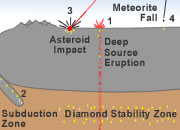 |
Diamonds from Coal? |
 |
What is a Geyser? |
 |
What is the San Andreas Fault? |
 |
Igneous and Volcanic Features |
 |
The Doorway to Hell |
 |
Topo Maps |
 |
Geology Dictionary |
 |
Gifts That Rock |

Find Other Topics on Geology.com:

|

| ||

|

| ||

|

| ||

|

|

